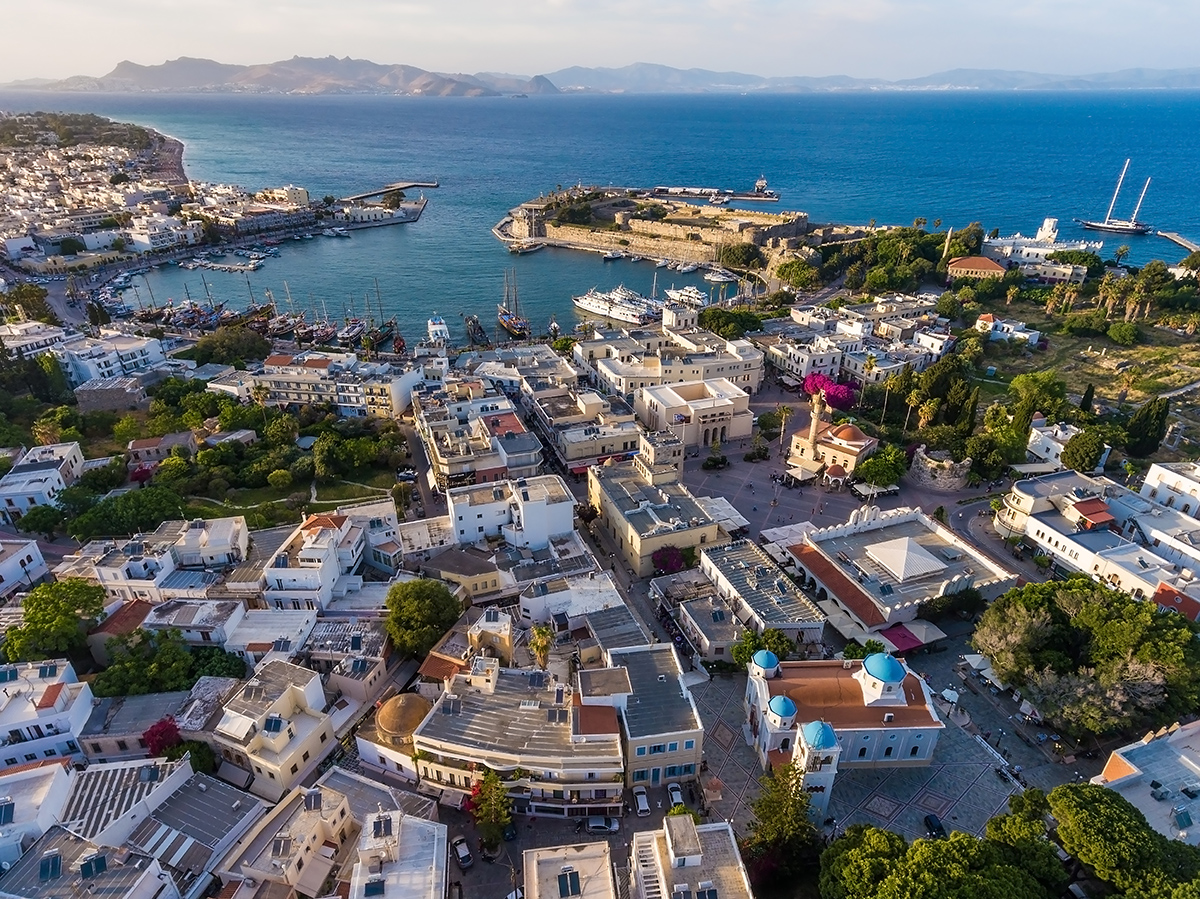Visit Kos Old Town and Harbour
The entirely pedestrianised Old Town commences at Freedom Square and concludes at Diagoras Square. It is consistently abuzz with activity, particularly from April to October when the island’s tourist season is at its peak. The entire neighbourhood overflows with charming cafes, inviting bars, quaint tavernas, and souvenir shops selling local crafts and gourmet produce, including olive oil, herbs, and honey.
The buildings display a captivating blend of Ottoman, Byzantine, and modern architecture, dotted with vibrant, Cherise pink blossoming bougainvillaeas patches and plentiful flower planters. Then, there are the main attractions you should not miss when visiting the Old Town and harbour.
- Archaeological Museum of Kos (Eleftherias Central Square): housed inside an architectural monument of the Italian Occupation. Within its impressive atrium, visitors are greeted by the striking sculptural adornments of the Roman Villa, famously known as “The House of the Abduction of Europa.” The exhibition within offers a captivating journey through the island’s history, spanning from the Prehistoric to the Hellenistic era, showcasing archaeological discoveries unearthed in the Sanctuaries of Kos, the Agora, and various other monuments, including the Altar of Dionysus, the Odeon, and the Roman Villa, providing a profound insight into the cultural tapestry of this ancient land.
- Neratzia Castle, an iconic 14th-century coastal fortress, stands proudly in the harbour of Kos. The fortress derives its name from the abundance of nerantzia (bitter orange trees) and lemon trees that densely adorned the landscape of Kos in the late 14th and early 15th centuries. Constructed by the Knights Hospitaller, it is a splendid testament to knightly fortification architecture in the Dodecanese. The Knights Hospitaller (Order of Knights of the Hospital of Saint John of Jerusalem) utilised numerous architectural elements from the ancient city of Kos and the Asklepion – still visible within several sections – to build the castle. The present-day form of the edifice is owed to the Italian Archaeological Service, which, during the Italian Occupation, undertook the demolition of Ottoman additions and embarked on an extensive restoration project to revive the castle to its original, illustrious form. An arched stone bridge interconnects the Hippocrates Plane Tree Square (Platanus Square or Plateia Platanou) with the castle itself.
- Hippocrates Plane Tree Square (Plateia Platanou) was once the enclosed medieval nucleus of the town, serving as the hub of the pre-seismic town. It was originally interconnected with the entrance of the Neratzia castle. Until the seismic event of 1933, the square accommodated the town’s headquarters, the town hall, a pharmacy, various shops, cafes, and the Gazi Hasan Pasha Mosque, also known as the Loggia Mosque. At the core of the square, you can see the revered 500-year-old Plane Tree of Hippocrates, possibly a descendant of the original tree that purportedly stood there 2400 years ago during Hippocrates’ time. Over the years, the tree has hollowed out, and some branches are reinforced with metal scaffolding. Adjacent to the Plane Tree of Hippocrates stands a fountain within an ancient bas-relief urn made of white marble constructed by the Turkish Governor Gazi Hassan. An inscription in old Turkish script on the urn reads: “Gazi Hassan erected the fountain, and water flowed from the spring of Hippocrates (i.e., Vourina spring) in 1200 (i.e., 1786 AD).”
- Turkish Bath House: Overlooking this historic building would be a missed opportunity. Once you locate it, be sure to step inside, as entry is free. Visitors gain a unique perspective on the Ottoman influence in Greece through the preserved bath houses, where the intricacies of washing and communal rituals come to life. Informative displays adorn the walls, offering a glimpse into the antiquity of the Turkish Bath House located near the harbour at the heart of Kos town. It only takes half an hour to get it all in.
- Defterdar Ibrahim Pasha Mosque is an 18th-century monument that symbolises faith and community for the Muslim-Turkish populace of Kos. Among the five Ottoman mosques that once graced the island, only two still stand: this grand edifice and the Gazi Hasan Pasha Mosque. Tragically, the Defterdar Mosque endured severe damage during the tumultuous earthquakes that shook Kos in 1926 and 1933. The Italians, who then held sway over the island, undertook an extensive restoration effort, which included the meticulous removal and subsequent restoration of the upper section of the minaret. Despite these earnest efforts, the minaret suffered further harm, necessitating another round of restoration in 2004-2005 to restore its former glory. However, the cruel hands of fate struck once more in 2017, as a powerful earthquake ravaged the minaret, causing it to collapse. Now, the noble structure stands silent and unused, patiently awaiting the culmination of the ongoing restoration efforts initiated by the local authorities in January 2023.
- Casa Romana: Situated to the west of Kos Old Town and in close proximity to the Roman Odeon, the Roman House stands as a significant archaeological site. This grand abode highlights the prevailing architectural style of the Hellenistic and Roman eras, encapsulating the essence of a bygone era. Akin to the majestic edifices discovered in Pompeii, this splendid mansion, dating back to the 2nd century, was erected upon the remnants of a Hellenistic-era dwelling. Beyond its glorious architecture, the house boasts an array of exquisite frescoes, notably featuring a striking portrayal of a panther engaging a bear, alongside intricate adornments, and statues from the late Hellenistic period. Additionally, the mosaic works within the house date back to the 3rd century AD, further enriching the historical tapestry of this remarkable site.
Simply strolling down the streets of Kos Old Town will offer plenty to do and see; besides noting architectural particularities and visiting the main attractions, shopping and dining are favourite pastimes here.

